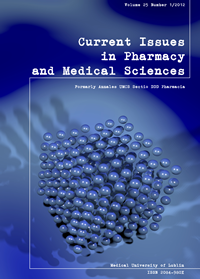Meclophenoxate ion-selective plastic membrane sensors and their pharmaceutical applications
DOI:
https://doi.org/10.12923/j.2084-980X/25.1/a.01Keywords:
anti-aging drugs, meclophenoxate, monitoring, membrane electrodesAbstract
The present work describes the construction and general characteristics of meclophenoxate ion-selective plastic membrane sensors, based on the use of a meclophenoxate–tetrakis(4-chlorophenyl)borate ion-pair complex as electroactive material, with 1-isopropyl-4-nitrobenzene (electrode A), 2-nitrophenyloctyl ether (electrode B), 2-nitrodiphenyl ether (electrode C) or bis(2-ethylhexyl) sebacate (electrode D) as solvent mediators. The electrodes show a linear response to the meclophenoxate concentration ranges of 10-4,1 – 10–2 moll-1 (electrode A), 10-5,1 – 10–2 moll-1 (electrode B), 10-4 – 10–2 moll-1 (electrode C), 10-4,9 – 10–2 moll-1 (electrode D), over the pH range of 4.12 – 6.18 with a cationic slope of 61.7; 64.7; 63,33; 64,41 mV decade-1, respectively. The response time varied from 5 to 20s, depending on the meclophenoxate concentration. Electrode B was used for the potentiometric determination of the content of meclophenoxate hydrochloride in pure form, dragees and dragee dissolution test, with average recovery and mean standard deviation (±SD) of 101.79 1.57, 102.72 0.91 and 101.32 ± 0.84 of nominal values respectively.
References
1. Bajgar J., Patocka J. and Vachek J.: An analytical method for determination of some pharmaceuticals containing an ester band. Cesk. Pharm. 23, 370, 1974.
2. Blazsek-Bodo A. et al.: Potentiometric titration of some pharmaceutical substances in nonaqueous medium using a platinum-pretreated electrode. Farmacia 33, 75, 1985.
3. Buck R.P. and Cosofret V.V.: Design of Sensitive Drug Sensors: Principles and Practice 1986.
4. Carretero J. et al.: Detection of banned drugs in sport by micellar liquid chromatography. Anal. Chim. Acta 259, 203, 1992.
5. Cosofret V.V.: Drug membrane sensors and their pharmaceutical applications. Trends in Analytical Chemistry. 10, 298, 1991.
6. Craggs A., Moody G.J. and Thomas J.D.R.: PVC matrix membrane ion-selective electrodes. J. Chem. Ed. 51, 541, 1974.
7. El-Bardicy M.G. et al.: Stability-indicating electrochemical methods for the determination of meclophenoxate hydrochloride and pyritinol dihydrochloride using ion-selective membrane electrodes. Yakugaku Zasshi. 127, 201, 2007.
8. El-Bardicy M.G. et al.: Kinetic study on the degradation of meclophenoxate hydrochloride in alkaline aqueous solutions by high performance liquid chromatography. Yakugaku Zasshi. 127, 193, 2007.
9. Faith L. et al.: Detection and separation of same psychotropic drugs by thin-layer chromatography using Silufol UV. Cesk. Farm. 23, 250, 1974.
10. Fu Z., Wang L. and Wang Y.: Capillary electrophoresis-electrochemiluminescent detection of N,N-dimethyl ethanolamine and its application in impurity profiling and stability investigation of meclophenoxate. Anal Chim. Acta. 638, 220, 2009.
11. Georgakopoulos C.G., Kiburis J.C. and Jurs P.C.: Prediction of gas chromatographic relative retention times of stimulants and narcotics. Anal. Chem. 63, 2021, 1991.
12. Gupta V.K. et al.: Recent advances on potentiometric membrane sensors for pharmaceutical analysis. Comb. Chem. High Throughput Screen. 14, 284, 2011.
13. Jane I., McKinnon A. and Flanagan R.J.A: High-performance liquid chromatographic analysis of basic drugs on silica columns using non-aqueous ionic eluents. II. Application of UV, fluorescence and electrochemical oxidation detection. J. Chromatogr. 323, 191, 1985.
14. Jastrzębiński J. and Gryz K.: Use of synthetic ion-exchange resins for the determination of active substances in drugs. Farm. Pol. 32, 1033, 1976.
15. Mascini M.: Uses of known addition Gran’s plots and the related methods with ion-selective electrodes. Ion-Selective Electrodes Reviews 1980.
16. Morf W.E.: The principles of ion-selective electrodes and of membrane transport. P. 11 Elsevier, Amsterdam, 1981.
17. Musumarra G. et al.: Qualitative organic analysis. I. Identification of drugs by principal components analysis of standardized thin-layer chromatographic data in four eluent systems. J. Chromatogr. 350, 151, 1985.
18. Musumarra G. et al.: Qualitative organic analysis. Part 2. Identification of drugs by principal components analysis of standardized TLC data in four eluent systems and of retention indices on SE 30. J. Anal.Toxicol. 11, 154, 1987.
19. Musumarra G. et al.: Application of principial components analysis to TLC data for 596 basis and neutral drugs in four eluent systems J. Chromatogr. Sci. 22, 538, 1984.
20. Ni B. et al.: A simple and sensitive HPLC method for quantification of the metabolin of meclofenoxate in human plasma. J Chromatogr Sci. 48, 353, 2010.
21. Obrsál J.: Methods of determining meclophenoxate and p-chlorphenoxyacetic acid. Sb Ved Pr Lek Fak Karlovy Univerzity Hradci Kralove Suppl. 26, 243, 1983.
22. Pungor E., Toth K. and Hrabeczy-Pall A.: Selectivity coefficients of ion-selective electrodes. Pure & Appl. Chem. 1913, 51, 1979.
23. Shoukrallah I., Sakla A. and Paletta B.: Quantitative determination of some pharmaceuticals in bulk drugs and tablets by proton magnetic resonance (PMR) spectroscopy. Farmaco. 45, 455, 1990.
24. Siska E. and Pungor E.: Potentiometric determination of tetraphenylborate ions with silver nitrate. Determination of silver, potassium and tallium. (I) Z. Anal. Chem. 257, 12, 1971.
25. Zając M., Pawełczyk E. and Jelińska A.: Chemia leków. WNAM, Poznań 2006.
26. Zs-Nagy I: A survey of the data on a new nootropic drug BCE-001. Ann. NY Acad. Sci. 102, 712, 1994.
Downloads
Published
Issue
Section
License
Copyright (c) 2012 Authors

This work is licensed under a Creative Commons Attribution-NonCommercial-NoDerivatives 3.0 Unported License.


